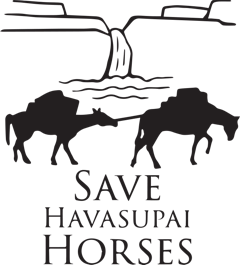KNOW BEFORE YOU GO
SAVE believes that if tourists to Havasu Falls knew better, most would choose to do better. This is why we work diligently to spread awareness about what life is like for many of the pack animals there, with the hope that tourists will make an ethical decision to pack their own gear, report signs of abuse, and encourage others to do the same. We need YOU to be voices for the pack animals.
Also, review our tips on practicing responsible tourism in Havasupai, and please share this information with anyone planning a trip there. (Get a PDF version of our checklist.)
What To Watch For
BASICS: Was there water, food and shade available at Hualapai Hilltop for the pack animals waiting to be loaded or unloaded with gear? Were the pack animals offered water before, during or after their trek through Havasu Canyon, to Hilltop and back?
BLATANT ABUSE: Did you see any animals struck with objects or beaten?
EXTREME CONDITIONS: Were the pack animals working in excessive heat?
UNNECESSARY TYING: Were there any horses or mules tied in the village for long periods of time, with no visible food or water offered, or with no slack for them to put their heads down?
HOOVES/LAMENESS: How did the animals’ hooves look – long, cracked, rough or untrimmed? How was their gait – were any limping or being drug along by the rest of the pack?
TACK FIT: Did their tack fit properly? Did you see sores on their bellies from the girth, sores by their tails from the straps rubbing them raw, etc.?
PACK WEIGHT: Did you notice any gear being weighed prior to the wranglers loading it onto the animals? Did the loads of gear on their backs seem excessive (coolers, heavy equipment, etc.)
VISIBLE WOUNDS/BONES: Were there visible wounds (open, bleeding, ulcerated, rubbed raw)? Did you see protruding hip bones? Could you see UNDER their packs?
BODY CONDITION: Were any of the animals, either working or loose in Supai Village, underweight or showing protruding ribs, hip bones, etc.?
PACK STRINGS: Were any of the pack animals tied together while working up and down Havasu Trail? Were they made to jog or run up or down the trail? (There is no reason for this – they should be walking ONLY for their safety and well-being, as well as for the safety of tourists.)
DECEASED ANIMALS: Did you see any animal carcasses on the side of the trail or down in the village? (It is not uncommon for horses and mules to collapse and die on the trail or to be fatally injured by falling off switchbacks.)
What To Do About What You Witness
If you witness abuse, report it immediately. Document it with photos and videos as it is reasonable to do so. Be sure to make note of the time and location and any specifics about the animal you see, making it easier to identify the animal later. Then contact SAVE, as well as the following agencies:
BIA Office in Supai: 928-448-2892
BIA Law Enforcement Unit in AZ: 602-379-6958
BIA Washington: 202-208-5787
Havasupai Animal Control Officer: 928-448-2161
Tribal Council: council@havasupai-nsn.gov
Council Chairman, Thomas Siyuja, Sr: 928-448-2731 | htchair@havasupai-nsn.gov
Council Vice Chairman, Edmond Tilousi: 928-812-4186 | htvchair@havasupai-nsn.gov
Havasupai Tribe’s Public Relations Contact
Abbie Fink: 602-957-8881 | Afink@hmapr.com

